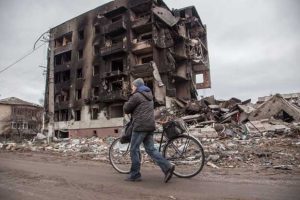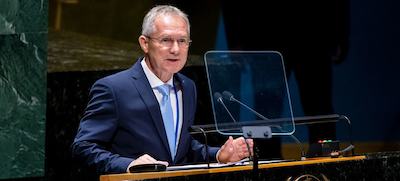- Jean–Christophe Gallagher appointed Executive Vice President, Aircraft Sales and Bombardier Defense
- Paul Sislian appointed Executive Vice President of Bombardier Aftermarket Services & Strategy
- David Murray appointed Executive Vice President, Manufacturing, IT and Bombardier Operational Excellence System
- Eric Filion joins Bombardier to the newly created role of Executive Vice President, Programs and Supply Chain
- Michel Ouellette will lead Engineering and Product Development until planned retirement later in 2023, following a 33–year, successful career
MONTREAL, Feb. 06, 2023 (GLOBE NEWSWIRE) — Bombardier today announced a leadership team evolution that will focus on carrying forward the company's positive momentum toward executing long–term growth and optimization strategies in the key areas of defense, services, continuous product improvement and next–generation manufacturing practices.
"Bombardier has successfully embarked on its journey as a company focused on its world–class business jet portfolio. As we continue to meet or exceed targets, it is the right time to thoughtfully reshape key leadership functions to ensure the solid foundation we have set fully carries our momentum well into the future," said ric Martel, President and CEO, Bombardier. "Our leadership team members are talented and have delivered on commitments time and again these past years, and this new alignment will further build upon the foundations they have successfully set for Bombardier."
As part the leadership structure evolution, the following alignments and appointments will take effect on February 20, and all other existing Bombardier leadership team members will continue in their roles:
Jean–Christophe Gallagher is appointed Executive Vice President, Aircraft Sales & Bombardier Defense. Gallagher will lead all aspects of Bombardier's growing defense business as its product offering and customer base expand. Gallagher will also oversee the talented Sales team led by Peter Likoray, Senior Vice President, New Aircraft Sales. Under Peter's leadership, Bombardier has grown its backlog and built local roots across the world. Peter will continue to deepen his and his team's passion for crafting unique experiences for Bombardier customers as they match their discerning needs to the company's exceptional portfolio.
Paul Sislian is appointed Executive Vice President, Bombardier Aftermarket Services & Strategy. Having spent 15 years optimizing and leading Bombardier's business jet manufacturing facilities and processes, Sislian will now carry forward and accelerate the division's strategic growth journey that saw Bombardier inaugurate four newly built or expanded maintenance facilities around the world in 2022.
All aerostructures, assembly and completions activities will be led by David Murray, who will add these responsibilities to his current mandates and is appointed to the role of Executive Vice President, Manufacturing, IT and Bombardier Operational Excellence System (BOE). The alignment of these three functions will enable a new focus on availing teams of next–generation digital technologies to further enhance Bombardier core processes.
ric Filion is appointed to the new role of Executive Vice President, Programs and Supply Chain. In this capacity, Filion will oversee all Bombardier supplier relationships and lead continuous, competitive improvement efforts for all in–production Bombardier aircraft. Filion previously held operations and program leadership positions at Bombardier, including oversight of the Challenger aircraft production facility. Most recently he served as Executive Vice President, Chief Operating and Customer Experience Officer for Hydro–Qubec. Filion will join Bombardier on February 20, 2023.
Finally, Michel Ouellette will lead Engineering and Product Development as the group's Executive Vice President. After a 33–year career at Bombardier that culminated in the successful certification of the Global 7500 jet and subsequent launch of the performance–leading Global 8000 flagship aircraft, Ouellette is set to retire at the end of June 2023.
"Michel's contributions to Bombardier can certainly be enumerated at great length, and their positive and lasting impact on our people, our products and our company is simply immeasurable," said Martel. "On behalf of everyone at Bombardier whose lives Michel has touched, I want to sincerely thank him for his leadership and passion""and wish him all the best in his next chapter. I also look forward to continuing collaborating in the months ahead, as we press forward with exciting projects."
About Bombardier
Bombardier (BBD–B.TO) is a global leader in aviation, focused on designing, manufacturing, and servicing the world's most exceptional business jets. Bombardier's Challenger and Global aircraft families are renowned for their cutting–edge innovation, cabin design, performance, and reliability. Bombardier has a worldwide fleet of approximately 5,000 aircraft in service with a wide variety of multinational corporations, charter and fractional ownership providers, governments, and private individuals. Bombardier aircraft are also trusted around the world in government and military special–mission roles leveraging Bombardier Defense's proven expertise."
Headquartered in Greater Montral, Qubec, Bombardier operates aerostructure, assembly and completion facilities in Canada, the United States and Mexico. The company's robust customer support network services the Learjet, Challenger and Global families of aircraft, and includes facilities in strategic locations in the United States and Canada, as well as in the United Kingdom, Germany, France, Switzerland, Italy, Austria, the UAE, Singapore, China and Australia."
For corporate news and information, including Bombardier's Environmental, Social and Governance report, as well as the company's plans to cover all its flight operations with Sustainable Aviation Fuel (SAF) utilizing the Book and Claim system visit bombardier.com. Learn more about Bombardier's industry–leading products and customer service network at businessaircraft.bombardier.com. Follow us on Twitter @Bombardier.""
Bombardier, Global, Global 7500, Global 8000 and Challenger are registered or unregistered trademarks of Bombardier Inc. or its subsidiaries.
For Information
Mark Masluch
Bombardier
+1–514–855–7167

GLOBENEWSWIRE (Distribution ID 8743397)












